Downtempo chord progressions can be the heart of any ambient or lo-fi track 一 setting the mood, creating the atmosphere, and bringing out emotions.
Plus, they have the power to add depth/space and make your music feel way more immersive.
As a lo-fi music producer, it’s important to know how to create these signature progressions so you can develop your unique sound and engage your listeners.
That’s why, in today’s article, we’re breaking down everything you need to know, like:
- Understanding downtempo chord progressions ✓
- Key elements of ambient chord progressions ✓
- The emotional impact of minor keys ✓
- Using extended chords (7ths, 9ths, 11ths) ✓
- Smooth voice leading and inversions ✓
- Incorporating slow tempo and syncopation ✓
- Top 9 modern downtempo chord progressions ✓
- Tips for creating atmosphere ✓
- How specific chords can change the entire vibe ✓
- Adding field recordings and samples ✓
After this article, you’ll know how to create downtempo chord progressions like the best of them.
This way, you can create tracks that truly resonate with your audience and stand out in the competitive music scene.
Plus, you’ll have the right tools to bring your musical ideas to life with confidence and creativity.
So, let’s dive in…
Table of Contents
Understanding Downtempo Chord Progressions
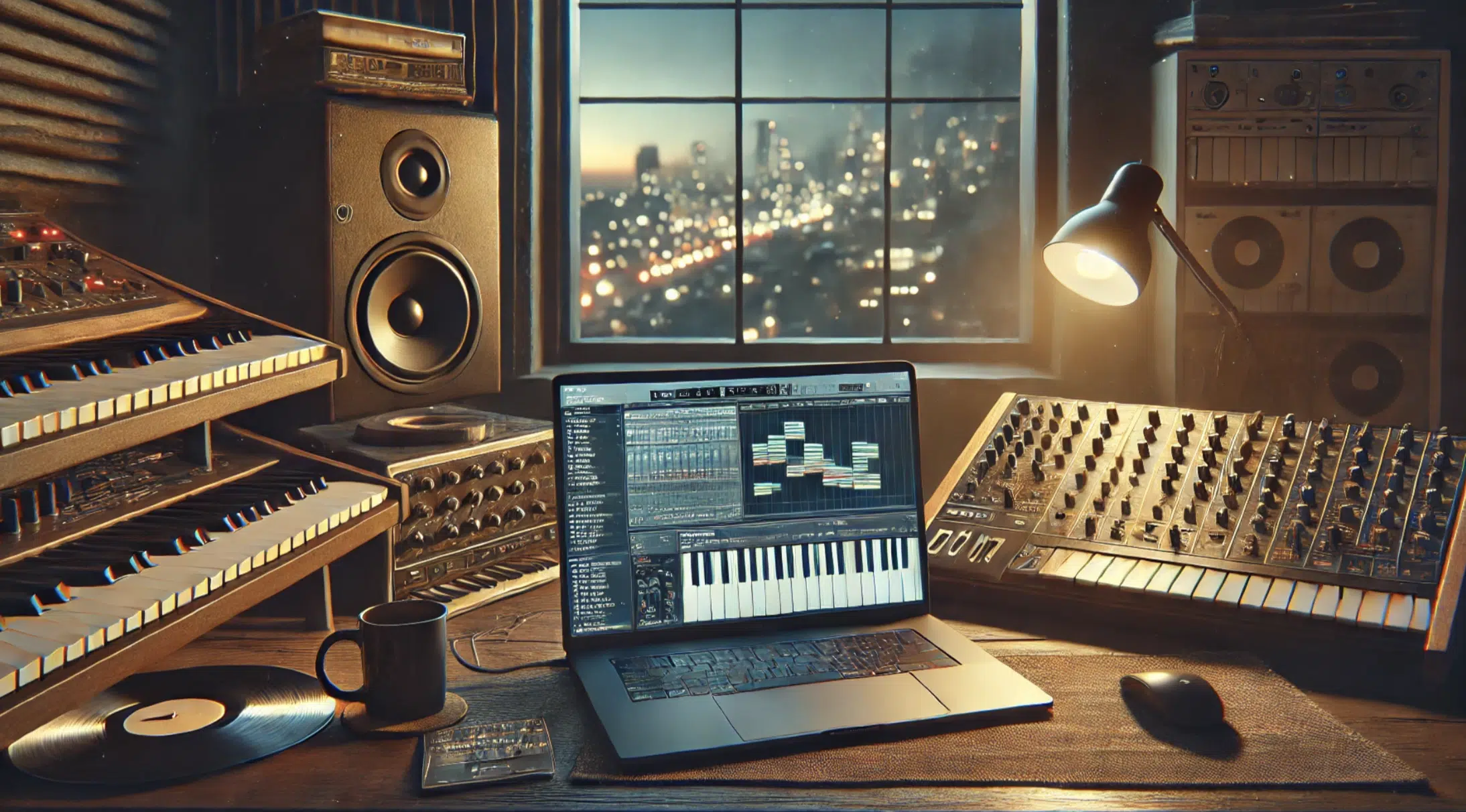
Downtempo chord progressions set the foundation for creating the ultimate ambient and lo-fi sounds that are getting more popular by the day.
What makes a chord progression feel downtempo lies in its use of:
- Slow tempos
- Lush chords
- Smooth transitions
These progressions usually utilize minor keys, adding an emotional and introspective quality to the music (which is their main thing).
The use of extended chords like 7ths, 9ths, and 11ths introduces complexity and depth, enhancing the ambient feel even more.
Voice leading and chord inversions play a huge role in keeping that fluid feeling between chords so each transition feels effortless.
Additionally, downtempo chord progressions often incorporate syncopation and off-beat rhythms, which contribute to a relaxed and laid-back groove.
The final soundscapes are rich, textured, and perfect for creating a more reflective atmosphere that people love.
By understanding these elements, you can knock out chord progressions that capture the essence of downtempo music.
Don’t worry, we’ll break everything down in detail so you really get the full picture.
Essential Elements of Downtempo/Ambient/Lo-Fi Chord Progressions
To dive deeper into downtempo chord progressions, let’s start by breaking down the essential elements that define their unique sound. They’ll help you understand how to create professional ambient chord progressions and lofi chord progressions.
-
Minor Keys and Their Emotional Impact
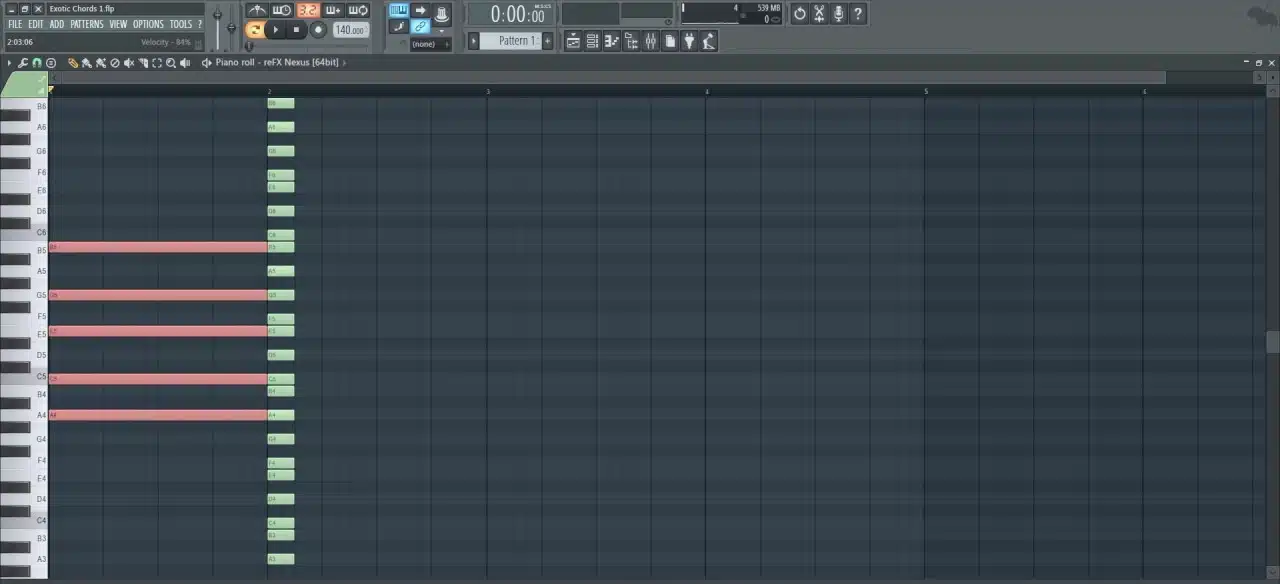
Minor keys are a staple in downtempo chord progressions because of their emotional depth and introspective quality.
They bring a signature sense of sadness, melancholy, and reflection, which makes them perfect for ambient and lo-fi music.
Minor chords like Em, Am, and Dm are commonly used 一 providing a somber yet soothing foundation.
The natural minor scale offers a range of notes that can be used to create epic melodies and harmonies…
For example, the A minor scale consists of A, B, C, D, E, F, and G, which you can use to build a minor triad and extended chord.
Using minor thirds within these chords adds to the emotional resonance.
By incorporating minor chords and scales, you can create chord progressions that tug at the listener’s heartstrings.
This emotional impact is a key characteristic of downtempo music, making it feel more personal and profound.
-
Use of Extended Chords (7ths, 9ths, 11ths)
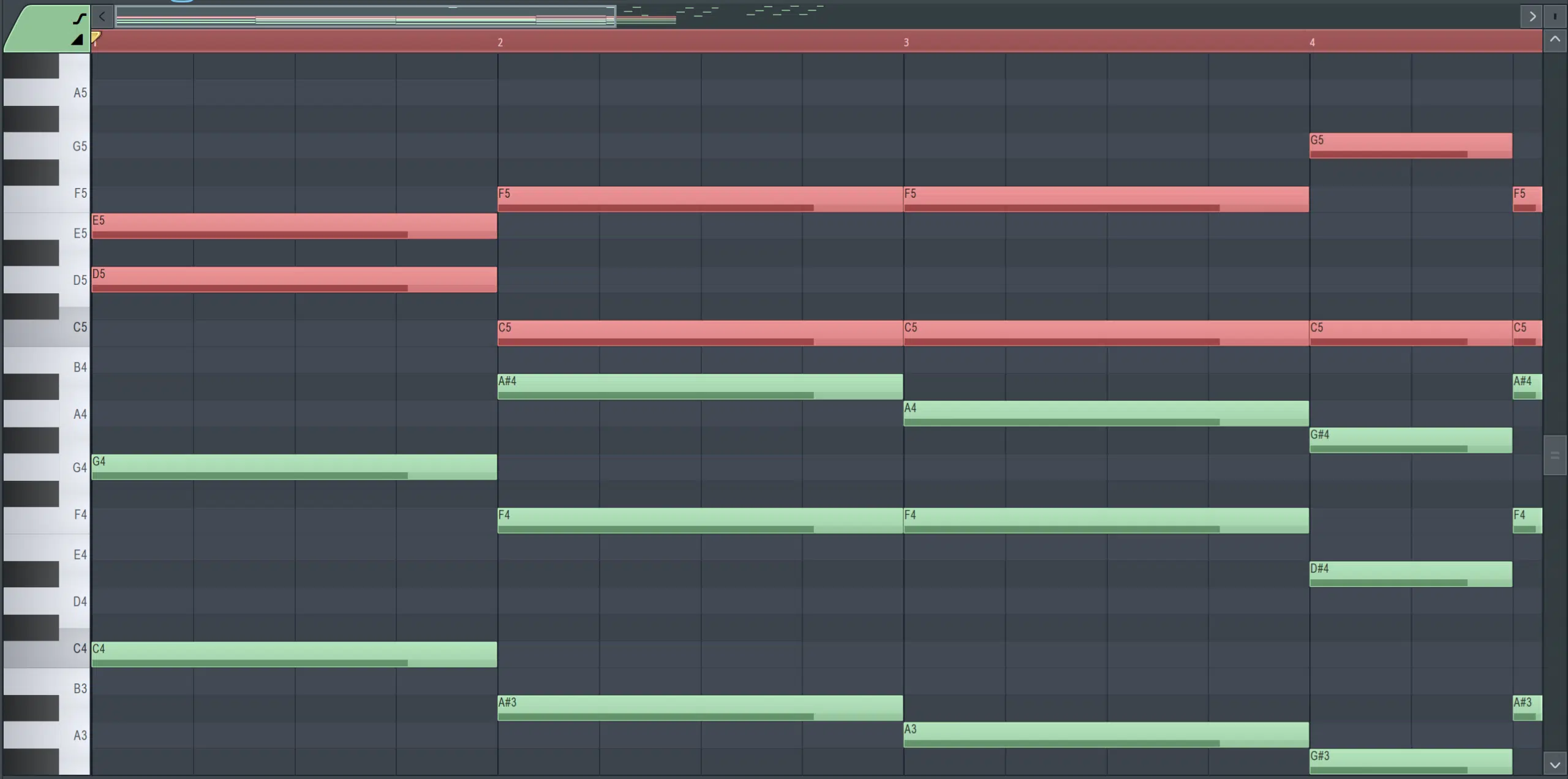
Extended chords like 7ths, 9ths, and 11ths add sophistication and texture to downtempo chord progressions.
These chords expand on the basic triads (minor triads/major triads) by adding additional notes to create more complex harmonies.
For instance, a Cmaj7 chord includes the notes C, E, G, and B, adding a smooth, jazzy feel that can instantly captivate your listeners.
Similarly, a G9 chord consists of G, B, D, F, and A 一 offering a fuller sound.
Extended chords provide a sense of lushness and depth that are essential for ambient and lo-fi music, allowing you to knock out more intricate progressions.
It enhances the overall atmosphere, which is what it’s all about.
By experimenting with different extended chords, you can add variety and interest to your music, so make sure to do so.
These chords are also great for creating dreamy and ethereal soundscapes, making them a favorite among ambient producers.
-
Smooth Voice Leading and Inversions
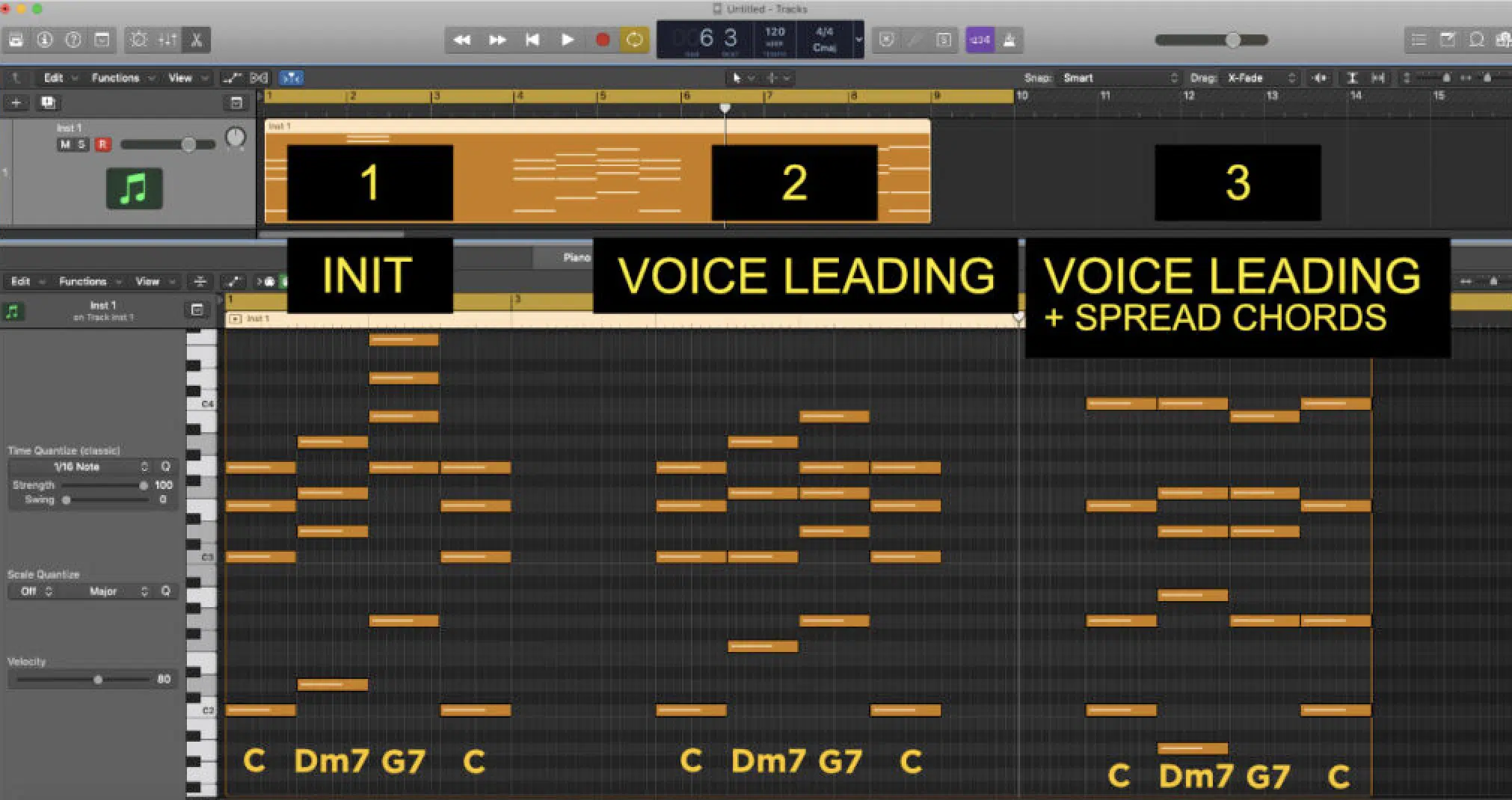
Smooth voice leading and inversions are key when you’re trying to create fluid and seamless downtempo chord progressions.
Voice leading involves moving individual notes within chords in the smoothest way possible, minimizing jumps and creating a natural flow.
Chord inversions, where the notes of a chord are rearranged, help achieve this smooth transition and offer endless creative possibilities.
For example, in a Cmaj7 chord (C, E, G, B), using an inversion like E, G, B, C can make the progression smoother.
This technique ensures that the chords blend into each other effortlessly 一 maintaining the relaxed feel of downtempo music.
By playing around with voice leading and experimenting with different inversions, you can enhance the cohesiveness of your progressions.
This approach not only improves the sound but also makes the music more engaging for the listener.
Smooth transitions are key to keeping the listener immersed in the ambient soundscape.
-
Slow Tempo and Syncopation
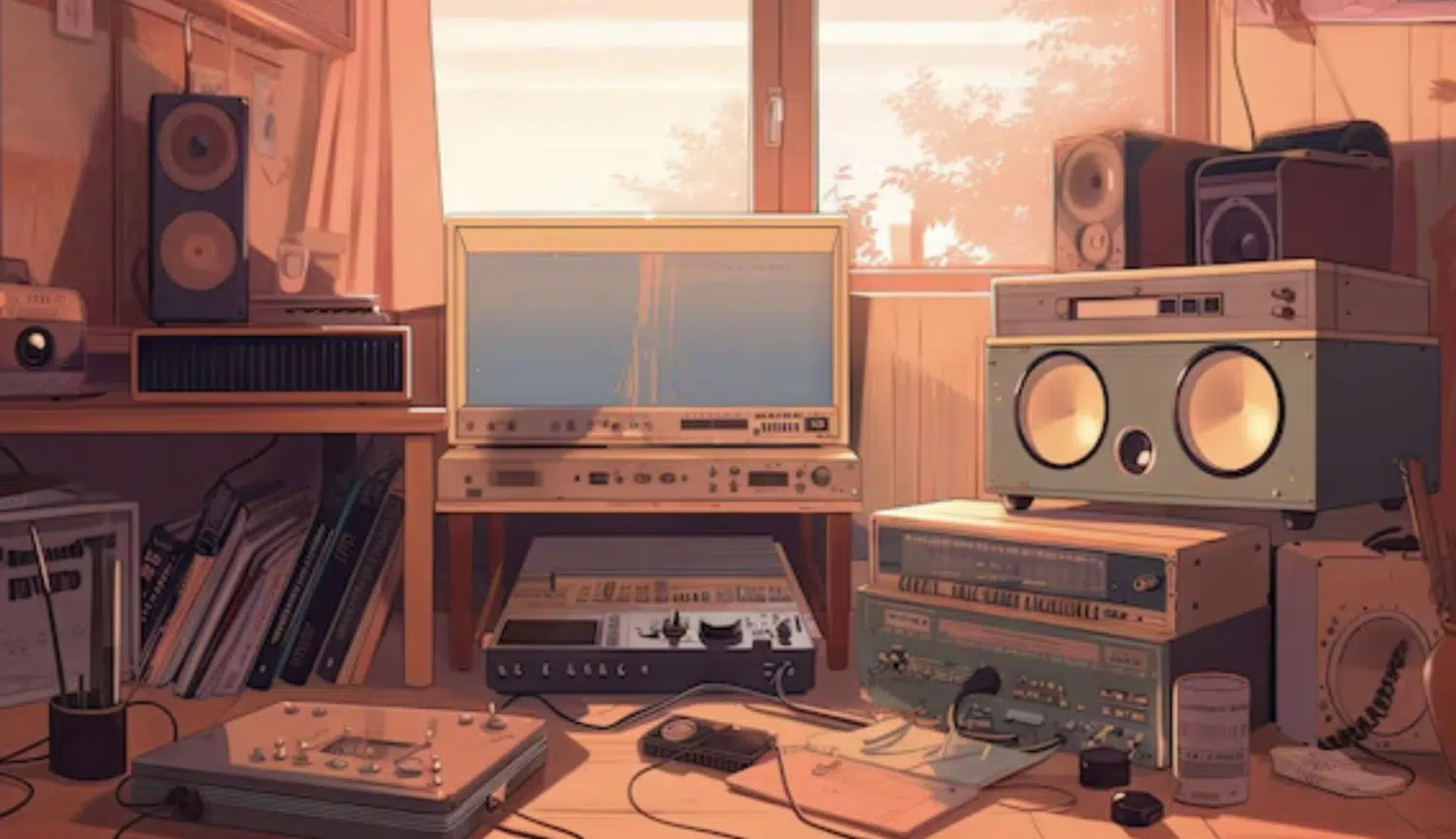
Slow tempos are a defining characteristic of downtempo chord progressions, typically ranging from 60 to 90 BPM.
This relaxed BPM allows for a more meditative and immersive listening experience.
Syncopation (the placement of rhythmic accents on off-beats) adds an element of surprise and groove to the music.
By combining a slow tempo with syncopated rhythms, you can create a laid-back yet engaging feel that people can really relate to.
For instance, placing a chord change on the “and” of a beat can create an interesting rhythmic pattern.
This technique keeps the music dynamic while maintaining a chill trap vibe that will ideally fit with the overall feel.
Slow tempos also give space for the chords to resonate 一 allowing their own timbre to be appreciated.
Incorporating both slow tempo/BPM and syncopation in your chord progressions will enhance the ambient and lo-fi quality of your tracks.
These elements work together to create a soundscape that is both soothing and captivating, solidifying yourself as a worthy lofi producer.
Pro Tip: Experiment with common tempos in the 70-80 BPM range to find the sweet spot for your ambient chord progressions, balancing relaxation with rhythmic interest.
Top 9 Modern Downtempo/Ambient/Lo-Fi Chord Progressions
Now that we’ve covered the essential elements, let’s dive into some specific downtempo chord progressions to give you a better understanding of how to create ambient chord progressions and lofi chord progressions that stand out.
1. Em – A – D – G
The Em – A – D – G chord progression is a straightforward yet powerful downtempo progression.
It starts with the minor chord Em, setting a melancholic tone, moves to A, then to D which creates a sense of anticipation, then to G that brightens the mood.
This downtempo chord progression flows smoothly, ideal for ambient and lo-fi tracks.
You can hear a similar progression in ODESZA’s “A Moment Apart,” which uses these chords to create a dreamy, atmospheric vibe.
The balance of minor and major chords provides emotional depth 一 making this downtempo chord progression versatile for different styles.
2. Am – Fmaj7 – C – G
Am – Fmaj7 – C – G is a key chord progression in ambient and lo-fi music, just like the previous chord progression.
Am sets a reflective, somewhat melancholic tone, transitioning smoothly into the lush Fmaj7 and moving to C (to introduce stability).
Finally, G rounds off this progression with a more uplifting tone.
This lo-fi chord progression is known for its emotional resonance and smooth flow.
Joji’s “Slow Dancing in the Dark” uses a similar progression 一 creating an evocative and melancholic atmosphere.
The extended Fmaj7 chord adds complexity, making this lo-fi chord progression ideal for emotionally engaging songs people really love.
3. Dm7 – G7 – Cmaj7 – Fmaj7
The Dm7 – G7 – Cmaj7 – Fmaj7 chord progression is rich in jazz influence, offering a sophisticated touch to downtempo tracks.
Dm7 introduces a deep, moody vibe, while G7 adds tension, resolving smoothly into the warm Cmaj7.
Fmaj7 provides a lush, full sound that completes the progression beautifully.
This ambient chord progression can be heard in Mac Miller’s “Dang!” 一 lending a nostalgic and reflective quality to the music.
The use of extended chords makes this ambient chord progression perfect for creating sophisticated, engaging soundscapes needed to master this intriguing genre.
By incorporating these chords, you can add a layer of depth and emotion to your tracks.
4. Cm – Ab – Eb – Bb
Cm – Ab – Eb – Bb offers a dramatic and evocative feel, common in downtempo music.
Starting with Cm sets a melancholic tone, transitioning to Ab to uplift slightly. Eb brings resolution, while Bb adds a touch of brightness.
Billie Eilish’s “Everything I Wanted” features a similar progression 一 creating a dreamy and emotional atmosphere.
This ambient chord progression is versatile and can bring a wide range of emotions to the table, making it a go-to for many producers.
The combination of minor and major chords creates a great variety of sound.
Side note, if you want to learn all about minor chords and major chords, we’ve got you covered.
5. F#m7 – B7 – Emaj7 – Amaj7
F#m7 – B7 – Emaj7 – Amaj7 provides a super smooth feel perfect for downtempo tracks.
F#m7 starts the progression with a mellow tone, while B7 adds tension (remember, tension is super important regardless of genre).
Emaj7 resolves this tension warmly, and Amaj7 rounds it off with richness.
FKJ’s “Tadow” uses a similar progression to create a soulful, relaxing vibe.
This ambient chord progression is ideal for creating tracks with depth and a laid-back feel 一 appealing to both ambient and lo-fi music lovers alike.
The extended chords offer a lush texture that enhances the overall sound.
6. Gm7 – C7 – Fmaj7 – Bbmaj7
Gm7 – C7 – Fmaj7 – Bbmaj7 is perfect for creating a rich, emotional atmosphere.
Gm7 sets a mellow, introspective mood. C7 introduces a bit of tension that resolves into the smooth Fmaj7; Bbmaj7 adds a final touch of warmth and complexity.
Tyler, The Creator’s “See You Again” uses a similar chord progression 一 enhancing the track’s dreamy and nostalgic feel.
This downtempo chord progression is excellent for creating deeply engaging soundscapes that your listeners won’t soon forget.
NOTE: The blend of minor and major seventh chords provides a sophisticated harmonic variety that you should really get familiar with.
7. Bm7 – E7 – Amaj7 – Dmaj7
Bm7 – E7 – Amaj7 – Dmaj7 combines sophistication with a smooth flow, ideal for downtempo music.
Bm7 begins with a reflective tone, E7 adds tension, and Amaj7 resolves it in the perfect warm way.
Dmaj7 rounds out the progression with depth and richness.
Tom Misch’s “It Runs Through Me” features a similar progression, adding a jazzy, laid-back vibe.
This lo-fi chord progression is perfect for creating tracks that are both sophisticated and soothing, appealing to a wide range of listeners (which is always great).
The use of extended chords makes this progression versatile and engaging.
8. Am9 – D9 – Gmaj7 – Cmaj7
Am9 – D9 – Gmaj7 – Cmaj7 is immersive, lush, and expansive which, as you now know, is perfect for downtempo and ambient music.
Am9 sets a rich, emotional tone, while D9 adds a jazzy flair. Gmaj7 brings warmth, and Cmaj7 completes the progression with a smooth, full sound.
Jacob Collier’s “Time Alone With You” uses a similar progression to add complexity and depth to the track.
This ambient chord progression is perfect for creating legendary, intricate soundscapes that captivate the listener.
And the extended chords provide a rich, layered texture, of course.
9. Em7 – A7 – Dmaj7 – Gmaj7
When it comes to lofi chord progressions, Em7 – A7 – Dmaj7 – Gmaj7 is a versatile option that really can make your listeners feel connected.
Starting with Em7 sets a deep, soulful tone, while A7 introduces a touch of tension that keeps the listener hooked.
Dmaj7 follows, offering a warm, soothing resolution that feels like a breath of fresh air.
Gmaj7 rounds out the progression with a bright, uplifting finish that adds a layer of hopefulness to the track.
This particular progression can be found in Loyle Carner’s “Yesterday,” where it creates a mellow, introspective atmosphere perfect for reflective moments.
The combination of seventh chords adds complexity and a jazzy feel 一 making this downtempo chord progression ideal for creating emotionally packed music.
Bonus Tips for Producers
Enhancing your downtempo chord progressions can transform your music into an immersive experience. So, as we wrap things up, let’s cover some great last minute tips for all ambient producers that will bring epic results.
-
Creating Atmosphere with Chord Progressions
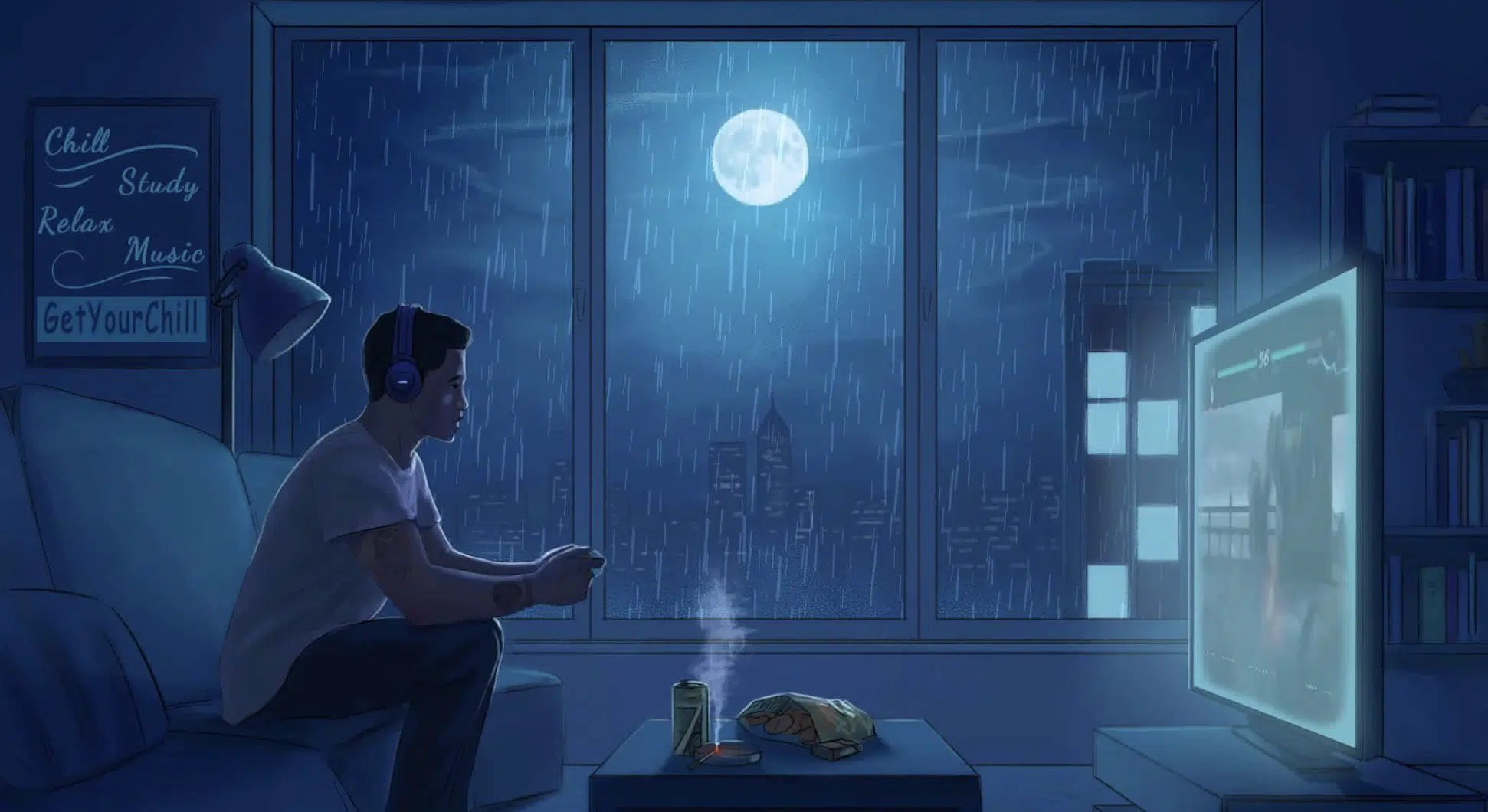
Atmosphere plays a key role in downtempo chord progressions.
To create a rich, immersive soundscape, start by layering your chord progressions with pads and synths that have a long attack and release.
This technique ensures that each chord transition feels smooth and natural 一 contributing to a fluid sound and more sci-fi atmospheres.
Reverb and delay are your best friends when it comes to adding depth and space.
Use these effects to create a sense of place and dimension within your track.
Try to throw in some mystical synths and subtle background sounds to add a touch of intrigue and texture.
Don’t forget to experiment with the EQ settings to carve out space for each element, ensuring they all sit well in the mix.
By carefully creating the atmosphere, you can make your downtempo chord progressions even more compelling and emotionally jam-packed.
-
Incorporating Field Recordings and Samples/Audio Loops
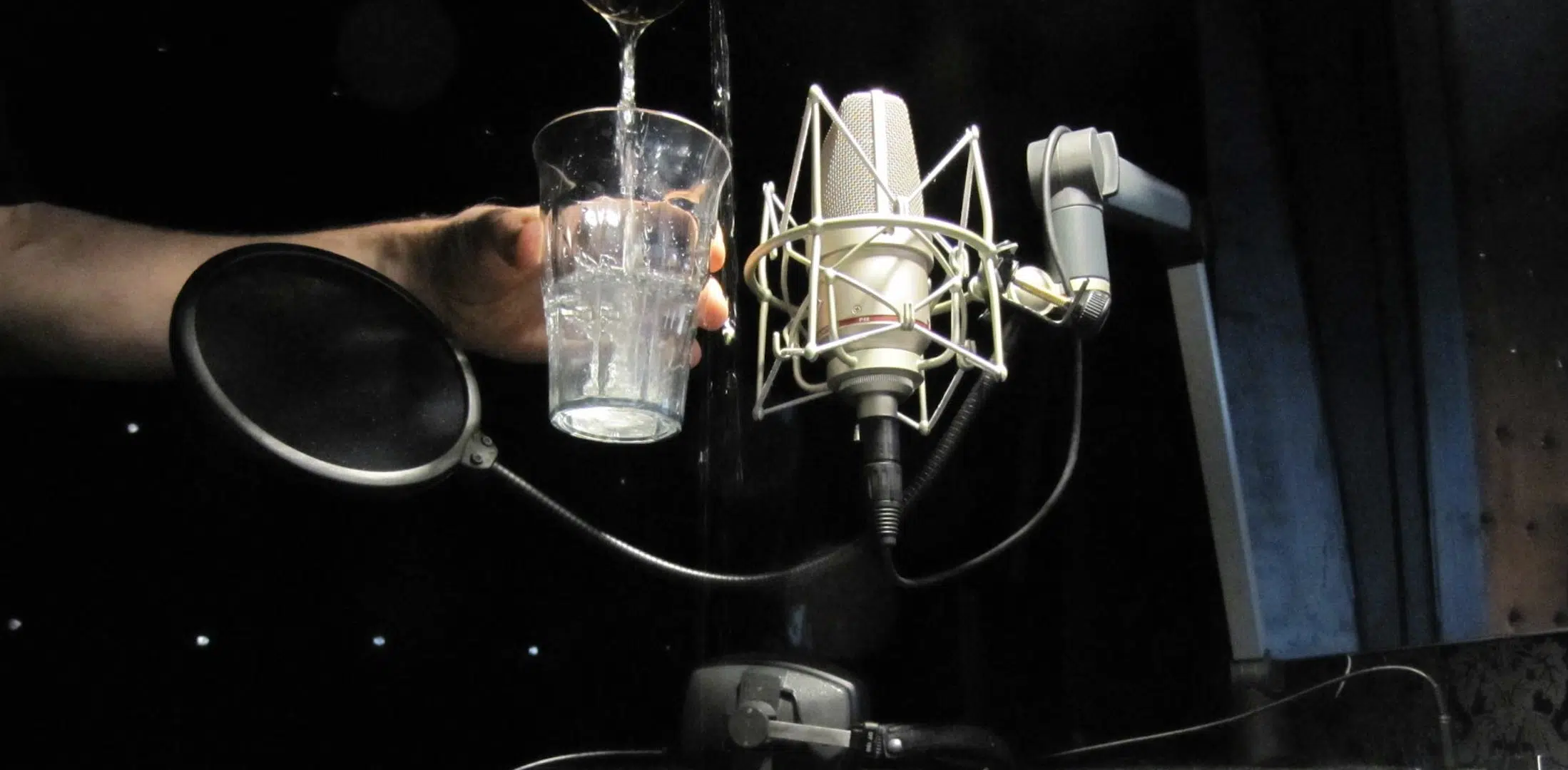
Adding field recordings and samples/audio loops can bring an extra layer of authenticity and depth to your downtempo chord progressions.
Start by recording ambient sounds from your environment, such as:
- Rain
- Wind
- Car sounds
- City noises
- Etc.
Then, layer these sounds subtly within your mix.
Audio loops, especially those with a nostalgic feeling, can also enhance your music.
So, try using audio loops of vinyl crackle or old tape recordings and sampled instruments like a piano or keyboard.
They can provide a familiar, organic touch that contrasts beautifully with electronic elements.
Be creative with how you integrate each sample and audio loop 一 using them to complement and enhance your downtempo chord progressions.
It’ll help you create unique songs with a distinct personal touch, whether it’s a simple two chord progression or a more complex variation.
-
Utilizing MIDI Effects and Automation for Chord Progressions
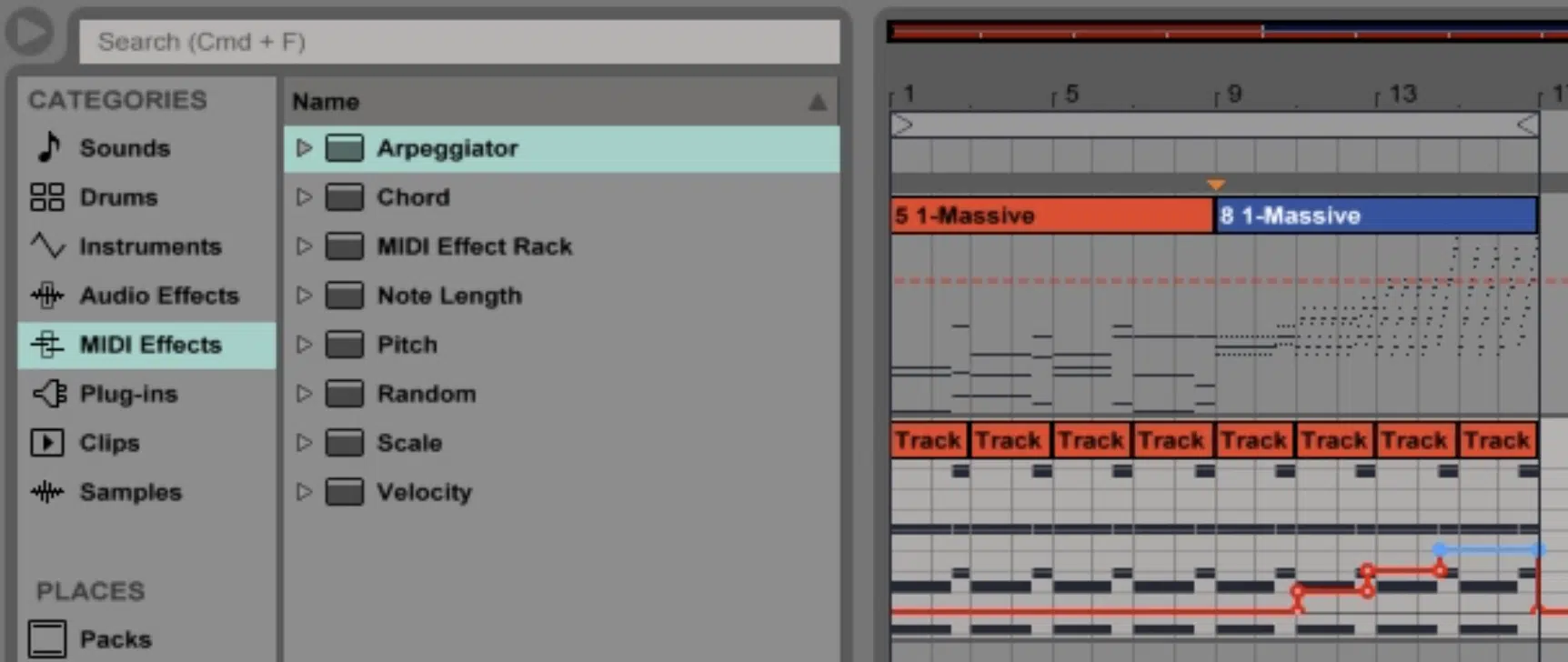
Using MIDI effects and automation can seriously enhance your downtempo chord progressions/lo-fi chord progressions.
Start by experimenting with different MIDI files to see how they can transform your music (you never know what you could stumble upon).
MIDI files are an excellent learning tool for trying out new ideas without committing to a specific sound.
Use MIDI effects like arpeggiators and chord generators to add complexity and variation to your chord progressions so they’re not basic/boring.
A great example would be applying an arpeggiator to a major chord, which can create a rhythmic pattern that brings life to your track.
Incorporating MIDI chord patterns can help you explore advanced music theory concepts, such as augmented chords, in a creative way.
Automation allows you to dynamically control parameters like reverb, delay, and filter sweeps, adding movement to your music.
By automating these effects, you can make sure that all the chords (even if it’s just two chords) in your progression evolve over time 一 keeping the listener engaged.
Don’t hesitate to use MIDI files to try the same chord in different contexts or to add subtle variations that make your music unique.
Downtempo Chord Progressions: Final Thoughts
Downtempo chord progressions, as you now know, can bring an extra layer of depth, emotion, and atmosphere to your tracks.
This way, people won’t get bored or distracted while listening.
Remember to play around with different voicings and inversions to really make your progressions stand out.
It will help you maintain a fresh sound while keeping your music engaging and immersive (which is what downtempo/lofi music is all about).
To help you even further, check out the legendary Free LoFi Sample Pack, which includes 60+ free LoFi samples, loops, and MIDIs to give you a serious edge.
It’s the best way for you to make your beats sound professional and placement-ready.
All the included samples are proper, polished, and perfectly processed and modeled off the styles of the biggest artists in modern music like A$AP Rocky, J. Cole, and more.
Plus, they were all created by top producers and sound designers, so you know you’ll be getting top quality.
47
It’s invaluable if you’re looking to create downtempo tracks that blow the competition out of the water.
Remember to always keep experimenting and pushing your creative boundaries to the limits.
This way, you’ll be sure to find your unique sound and get your music to the top of the charts.
Until next time…







Leave a Reply
You must belogged in to post a comment.